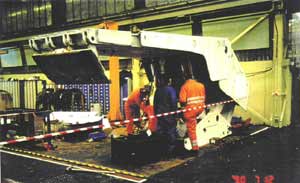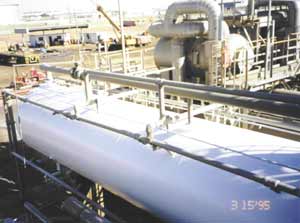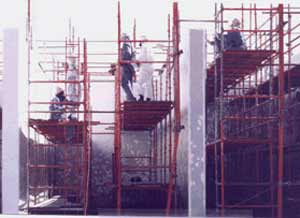

We offer a complete line of non-stick, Fluorinated Polyurethane (FPUTM) coatings to extend the life of your expensive equipment and machinery. We manufacture these patented polymers under licenses from the U. S. Naval Research Laboratory (NRL), which originally developed these coatings for military applications. The Navy Facilities Engineering Command (NAVFAEC) specifies FPUTM for the interior lining of its welded-steel fuel tanks. Several of our systems are certified in the Lloyds Registry (for Refined Spirits Tanks, Crude Oil Tanks, and Bilge and Double Hull Void Spaces).
An FPUTM surface has a very low surface energy (non-stick); it is chemically extremely stable (non-reactive), flexible, abrasion resistant, and impermeable to oxygen and water. FPUTM provides:
 These properties translate into lower cost of ownership.
FPUTM
reduces the need for maintenance, reduces the maintenance effort, and
reduces the maintenance downtime.
These properties translate into lower cost of ownership.
FPUTM
reduces the need for maintenance, reduces the maintenance effort, and
reduces the maintenance downtime.
FPUTM has protective properties that are comparable to baked-on Fluorinated polymers (such as PTF or PVDF coatings) but it has two advantages. FPUTM is:

We manufacture several FPU-based products that are optimized for the following applications:
FPU WC-1TM provides cost-effective FPUTM protection for normal environments. It extends the life and preserves the appearance by preventing UV radiation damage, and inhibiting corrosion. The first picture on this page shows Mooranbah North Coal mining equipment, protected by WC-1TM and WC-1 (AP)TM.
FPU WC-1 (AP)TM is a variety of WC-1 that is optimized for UV resistance, and for gloss and color retention.
FPU WC-1 (BA)TM is a variety of WC-1 that is optimized to resist soiling by graffiti. The second picture on this page shows an engine of the Great Northern Rail in Australia protected with WC-1(BA) AntiGraffiti coating.

FPU WC-2 (H)TM is a variety of WC-2TM that is enhanced with PTFE to resist petroleum products. WC-2TM is designed for mechanical toughness that is suitable for severe environments.
FPU WC-15TM provides the same protective properties as WC-1, but it is optimized to be mechanically tough. WC-15 TM is recommended for splash zone applications where the coating must withstand, mechanical ware, UV radiation, and salt-build-up from repeated wetting and drying. It is ideal for off-shore facilities and sea-water intake structures. The fourth picture on this page shows a seawater intake structure in
FPU WC-1 (NS)TM
is a variety of WC-1 that is blended with a soft, (non-cutting) traction-enhancing additive
that provides a durable non-skid surface for wet or slippery floors, walkways, or stairs.
The fifth picture on this page shows WC-1 NSTM
being applied to the loading dock at a Dixie Supermarket in Florida.

FPU WC-15TM Is ideal for areas that are partially or fully immersed in fresh or salt water. One WC-15TM system is approved in Australia (ICPW AS4020) for portable water applications. It is also Lloyds certified (MATS/2481/1) for Salt Water Ballast Tanks.
FPU WC-5TM is optimized for applications that require resistance to petrochemicals and corrosive wastes but do not require UV protection. It is intended for interior applications such as machine rooms, or the lining of CHT tanks. It is Lloyds certified for Refined Spirits Tanks (MATS/2482/1), Crude Oil Tanks (MATS/2483/1), and Bilge and Double Hull Void Spaces (MATS/2484/1). Navy Facilities Engineering Command (NAVFAEC) specifies FPUTM WC-5TM for its new large (250 barrel to 300,000 barrel) shore-based fuel tanks. The last picture on this page shows one of the U.S. Navy's jet fuel tanks that has a WC-5TM lining.

A typical system for steel is as follows:
A typical system for concrete is as follows: